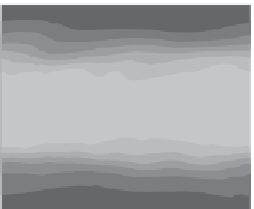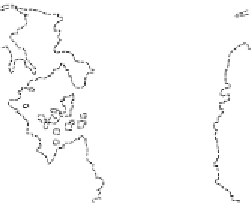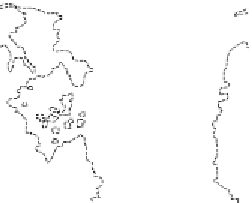Environmental Engineering Reference
In-Depth Information
(a)
(b)
E1: 240 km
3
pyroclastic eruption
1.46 Gt/year SO
2
(for 1 year)
E5: 2,400 km
3
pyroclastic eruption
14.6 Gt/year SO
2
(for 1 year)
5
5
Siberian Traps
Siberian Traps
Siberia
50˚ N
50˚ N
Siberia
4
4
Baltica
Greenland
Baltica
Greenland
China
China
Laurentia
Laurentia
3
0˚ N
Tethys
Panthalassa
3
0˚ N
Tethys
Panthalassa
S. America
S. America
Africa
Africa
2
2
50˚ S
50˚ S
India
India
Australia
Australia
1
1
Antarctica
An
ta
r
c
t
i
c
a
100 ˚ E
200 ˚ E
300 ˚ E
0 ˚ E
100 ˚ E
200 ˚ E
300 ˚ E
0 ˚ E
(c)
(d)
0%
0%
E3: pyroclastic eruption
1.46 Gt/year SO
2
(for 2 years)
0.14 Gt/year HCl (for 2 years)
3x background CH
3
Cl emissions
P2: large pipe
1.43 Gt CH
4
4.29 Gt CH
3
Cl
Siberian Traps
Siberian Traps
10%
10%
Siberia
Siberia
50˚ N
20%
50˚ N
20%
Baltica
Greenland
Baltica
Greenland
30%
30%
China
China
Laurentia
Laurentia
40%
40%
Tethys
Panthalassa
Tethys
Panthalassa
0˚ N
0˚ N
50%
50%
S. America
60%
S. America
60%
A
frica
Africa
70%
70%
50˚ S
50˚ S
India
India
Australia
Australia
80%
80%
Antarctica
Antarctica
90%
90%
0 ˚ E
100 ˚ E
200 ˚ E
300 ˚ E
0 ˚ E
100 ˚ E
200 ˚ E
300 ˚ E
Figure 20.4 (a) Rainfall pH during a 1-year, 240 km
3
eruption. Simulation E1
from Black
et al
.(
2014
). (b) Rainfall pH during a 1-year, 2400 km
3
eruption.
Simulation E5 from Black
et al
.(
2014
). (c) Ozone depletion during a 3-year, 720
km
3
eruption, assuming 75% of degassed HCl reaches the stratosphere, and with
10
pre-industrial CH
3
Cl emissions. Simulation E3 from Black
et al
.(
2014
).
(d) Ozone depletion after a large pipe eruption that releases accumulated CH
3
Cl
and CH
4
from contact metamorphism (Aarnes
et al
.,
2011
). Simulation P2 from
Black
et al
.(
2014
). A black and white version of this
figure will appear in some
area would be expected (
Figure 20.4b
). Such drastically acidic rain could produce
highly stressful environmental conditions for northern hemisphere
flora and fauna
(Howells,
1990
). SO
4
has an e-folding time in the stratosphere of around 1 year
(Barnes and Hofmann,
1997
); therefore, sulfuric acid rain, which is located in the
troposphere, abates quickly after an eruption ceases.
The expected intensity of acid rain during other
flood basalt eruptions depends
largely on atmospheric CO
2
levels and the quantity of sulfur released to the
stratosphere. Sulfur emissions from the Deccan Traps and the Columbia
River
flood basalts were volumetrically comparable to those during the Siberian
Traps (Blake
et al
.,
2010
; Self
et al
.,
2008
). During the eruption of the Central
Atlantic Magmatic Province (CAMP) at the Triassic
-
Jurassic boundary, CO
2
levels
may have been even higher than during the Permian
-
Triassic (Schaller
et al
.,
2011
).




























































































































































































































































































































































































































































































































































